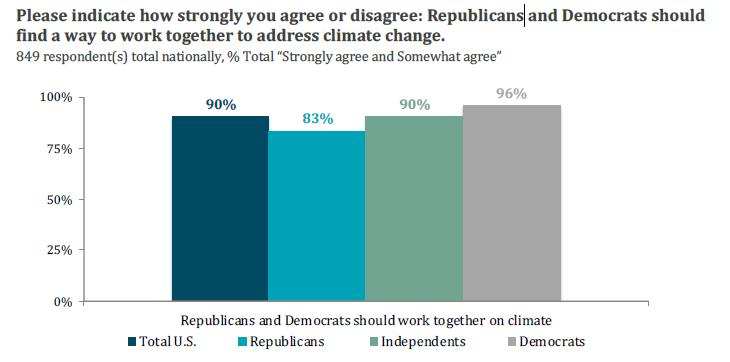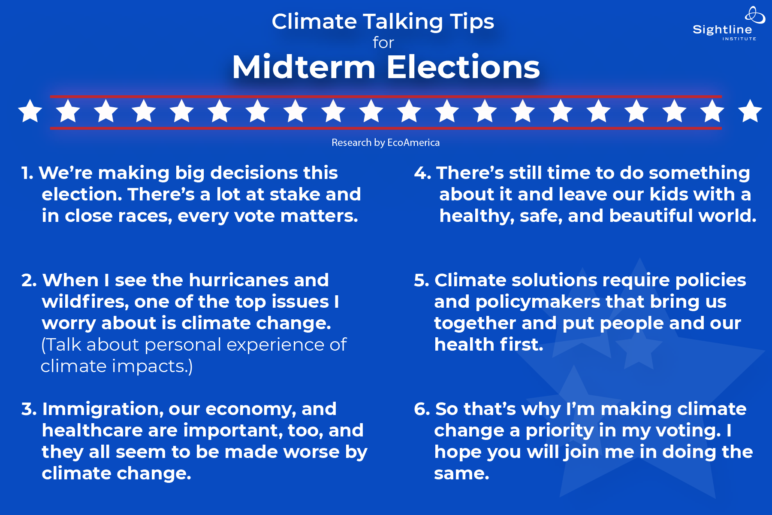With partisanship becoming more venomous every day and midterm campaigns ramping up, it may be shocking to learn that Americans from across the ideological spectrum are actually coming closer on one issue: climate change.
As back-to-back storms ravage the East Coast and dire warnings come once again from scientists with the Intergovernmental Panel on Climate Change (IPCC), more Americans than ever are accepting the reality of our changing climate.
90 percent of Americans think that policymakers should find a way to work together to address climate change.
Of greater importance for the coming elections, three in five Americans from across political affiliations report feeling more concerned about climate change now than in past elections. This includes most Democrats and Independents, but more surprising is that even a third of Republicans report this increase in concern.
Additionally, a whopping 90 percent of Americans think that policymakers should find a way to work together to address climate change, including 83 percent of Republicans and 90 percent of Independents.
A majority of Americans disapprove of the current administration’s environmental protection rollbacks as well, including 64 percent of Independents, who now make up the largest voting bloc in the US, and 23 percent of Republicans – almost one in four. This is a telling departure, in contrast to the 91 percent of Republicans who nonetheless approve of Donald Trump.

Accepting the realities of climate change is less and less a partisan stance. American Climate Perspectives Survey by ecoAmerica (Used with permission)
And now for the bad news: while people under 45 years old are more likely to say they are concerned about climate change than older Americans, younger people are also less likely to vote. And I mean a lot less likely: only 71 percent of people under 45 indicated that they plan to vote in the upcoming elections, versus 92 percent of Americans older than 45—a notable 21 point difference. And actual voter turnout shows younger people vote in smaller numbers than they plan.
Older voters are also better informed about the candidates running in their districts and they’re more likely to say that the midterms are “very important.” As ecoAmerica’s report puts it, “The climate movement would benefit from voter turnout campaigns targeting Millennials/Adults under 45.”
Another interesting point: while a majority of Democrats and Independents report that they would like to know more about their candidates’ positions on climate change, 45 percent of Republicans said that they do not want to know more about their candidates’ views.
But overall, most Americans now report being more likely to vote for a candidate who supports climate solutions, indicating that climate is indeed a significant voting issue.
Polling shows that partisans agree on this issue more than they might realize. Young people especially could determine who gets into office and how much progress the next years hold for state and federal climate policy—but only if they actually vote.
We can all do our part to keep climate momentum rolling right up to voting day. Here are some handy talking tips from ecoAmerica to start more discussions with Americans of all political stripes and keep those conversations moving in the right direction:
Once you get those conversations started, here are some bonus tips for connecting with conservative values on climate:
- We all care about the same things: our children, health, and communities. We know that clean air, clean water, and thriving nature around us keeps us healthy.
- Most Americans, of all political persuasions, want less pollution and more clean energy. The federal government wants to subsidize coal plants because they are no longer competitive. This distorts the market and causes more pollution than is necessary.
- We can create good-paying, local jobs if we produce our own clean energy and we use energy wisely. The world is shifting this way, and America is lagging behind.
- We can protect our climate and our community at the same time. Now that clean energy costs less than coal or oil, let’s start investing in our future.











